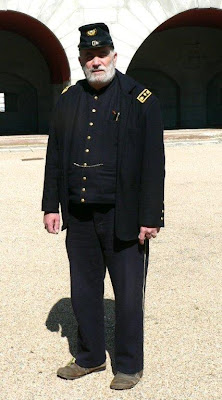Monday, February 15, 2010
Monday, February 8, 2010
Sgt. John Proctor
This was the bunker at Fort Nathan Hale in New Haven where the Northeast Topographical Engineers built bunks, benches, table, and three interior window shutters within the bunker, cleared the chimney and built a chimney cover, replaced the wooden planking in both entrance tunnels, and painted the wooden interior with preservative. The outside work included:
--Removing a rotted lower gun carriage;
--Building a small gun carriage; and
--Painting the upper gun carriage;
--Straightening the Moat bridge axles;
--Clearing the one outside gun platform for replacement of the flooring.
Ian McKay and British Civilian Host
Ian McKay, and friends at one of the Connecticut River Annual Rendevous. We were, at that time, in the Rev War section of the event
Friday, February 5, 2010
Judge Thomas Lee
Judge Thomas Lee (aka Jim Mathews), Royal Magistrate, East Lyme Region, His Britannic Majesty's Colony of Connecticut, North American Colonies.
The Battle of Honey Hill #2
This is the second Map of the Battle of Honey Hill. Some of the printed items follow:
Note 1 - This map was prepared for Col Colcock, who remarked that it was accurate but exaggerated the size of the Confederate defense works. Lt. Col Colcock was the Commander of the Confederate Forces in the area around Grahamsville, but at the time of the battle, was some fifty miles away.
Note 2 - Confederate works, one hundred yards long with six guns of field artillery.
Note 3 - Line of battle of the Confederates included about one and one half miles.
Note 4 - Distance from Grahamsville to Boyd's Landing - seven miles.
Note 5 - Distance from Grahamsvulle to Honey Hill - five and one half miles.
Legend:--
A- Confederate Batteries;
B-Low swampy ground with slash of water at the foot of Honey Hill;
C-Woods;
D-Causeway with ridge where the Federals were checked;
E-Line of Federal entrenchments;
F-One Confederate gun on Coosawatchee Road, not engaged;
1.-Major Jackson's Battalion;
3.-Georgia Reserves;
3.-Major Jenkins;
4.-49th Georgia Reserves;
5.-Major Cookes Battalion;
6.-32nd Georgia Reserves;
7.-General Smith, Confederate Commander of Confederate Reenforcements.
Thursday, February 4, 2010
Destruction Island
U. S. Coast Survey -- West Coast of the United States -- Grey's Harbor to Admiralty Inlet -- 1853 -- NW (compass), 6 miles.
Flattery Rocks -- White Rock
U.S. Coast Survey -- West Coast of the United States -- Grey's Harbor to Admiralty Inlet -- 1853 -- N by W by N (compass), 5 miles.
Wednesday, February 3, 2010
Morro Rock
Sailing Directions -- Pacific Coast -- 1853
"View of Morro Rock, Estero Bay, N by E, 10 miles. In Estero Bay Morro Rock is a high conical rock, and is a good landmark, particularly for vessels coming from the sea. Behind it there is quite a body of water partaking somewhat of the character of a lagoon."
Santa Catalina Harbor
Sailing Directions -- 1853
"The harbor is on the SW side of the island by the same name. It's approaches are bold and clear from hidden dangers. When abreast of the entrance which is marked by a low neck of land extending across the island. At some distance from it the land appears like two very high islands. Stand in for the opening and anchor on either side at Ballast Point. Inside of Ballast Point there is hardly room for a vessel to swing at her anchor, but as the harbor is perfectly land-locked, she can moor by running a hawser to the rocks and lie with perfect safety."
Monday, February 1, 2010
The Battle of Honey Hill
The Battle of Honey Hill was an ill-conceived attempt from the beginning. It was planned with no idea of the terrain or defenses in the area and as a result culminated in a rout for the Federals and a significant victory for the Confederates. The problem was that Gen. Robert R. Lee had constructed two redoubts and a trench-line on a rise above an extensive swamp and which commanded the only road over the swamp and small creek system which lay to the front of these defenses.
The Confederate forces arrived in the redoubts and trench-line just minutes before the Federals had come on the scene. They (Federals) had been delayed in their arrival by marching the wrong way on the road from Boyd;s Landing and thus were late on the scene. The very railroad that they were to seize, transported the Confederate troops to the Honey Hill defenses.
Reference --Sharon S. MacDonald, W. Robert Beckman, "Heroism At Honey Hill," North South Magazine (Vol. 12 - No.1) Feb, 2010, Pages 20 -41
Subscribe to:
Posts (Atom)





















